Welcome back. This past Wednesday we had an inspiring gathering with the priests of Boston, of which I will say more at the end of this week’s post.
Recently, Sister Bridget Haase visited to present me with a copy of her newly published book, “Generous Faith: Stories to Inspire Abundant Living.”
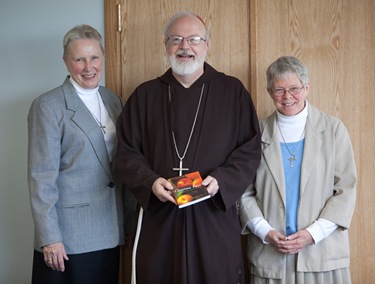
Sister Angela Krippendorf, Provincial of the Ursuline Sisters of the Northeast Province and Sister Bridget
I wrote an introduction to the book in which I said that Sister Bridget has given us a valuable resource for finding the presence of God in the midst of our daily life.
In addition to sharing powerful stories of seemingly ordinary experiences, Sister directs us to take the time to ponder, reflect and be attentive to the ways the Lord is working in our lives.
The book encourages us to experience the generosity of God by learning how to live in the now, to trust the divine care and to find God everywhere. You can find more information on Sister’s works here.
Sister Bridget is the Spirituality Coordinator at The Boston Home, a long-term care facility for people with multiple sclerosis and other degenerative diseases.
– – –
This year we are sending seminarian Tom McDonald to study at The Pontifical North American College, America’s seminary in Rome. He will join Eric Bennett who is already studying there.
As is the custom, the seminarians who study at The North American are received into the ministry of candidacy to the clerical state prior to their departure to Rome.
So, on Friday we had the Mass of Candidacy at the Blessed Sacrament Chapel at the Cathedral of the Holy Cross with Tom and his family, some of the seminarians and the rector of St. John’s, Father Arthur Kennedy.
– – –
On Sunday we had a huge success at our annual 25th and 50th wedding anniversary Mass at the cathedral. The cathedral was filled with a large number of couples celebrating their silver and golden anniversaries who were accompanied by many friends and family members.
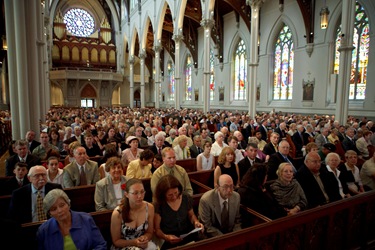
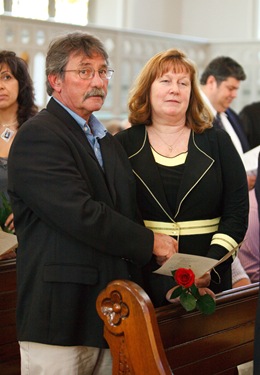
The couples renewed their vows as part of the ceremony and I thanked them for their witness of love and fidelity in the sacrament of marriage, which is the centerpiece of God’s plan for humanity. It is just as St. Paul tells us — the sacrament is a sign of Christ’s love for his bride, the Church. I asked the anniversary couples to encourage young people to have the courage and generosity to embrace this vocation of marriage, which is so important for society and for the life of the Church.
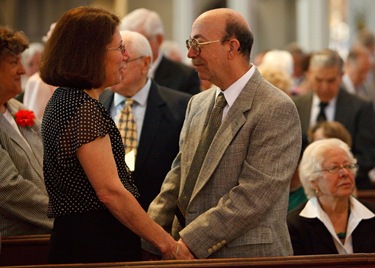
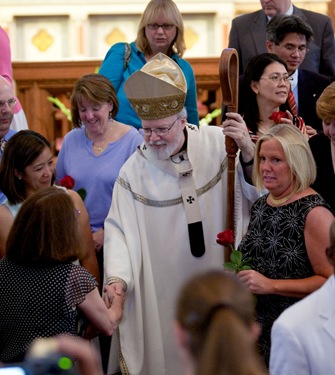
Father Mark O’Connell, our Judicial Vicar, concelebrated at the Mass as his parents were celebrating their 50th wedding anniversary.
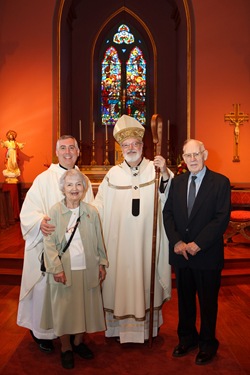
With Father Mark and his parents
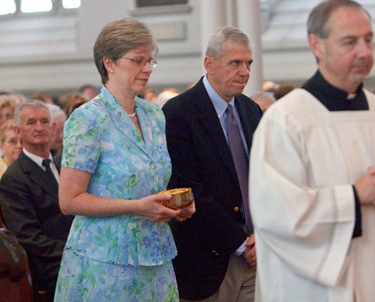 I was also pleased to see Mary Finnigan, our Natural Family Planning Coordinator, who is celebrating her 25th anniversary with her husband James.
I was also pleased to see Mary Finnigan, our Natural Family Planning Coordinator, who is celebrating her 25th anniversary with her husband James.
We are very grateful to Kari Colella, our coordinator of marriage ministries, who organized the celebration.
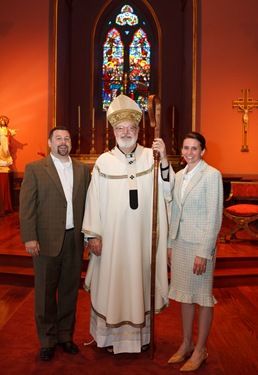
Stephen and Kari Colella
Photos with the Silver Anniversary couples:
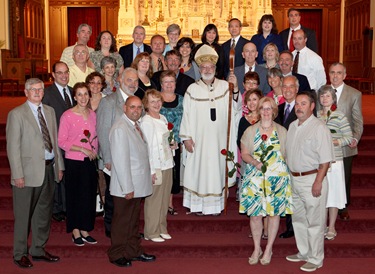
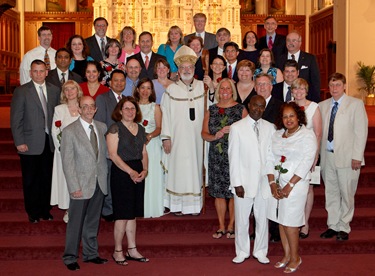
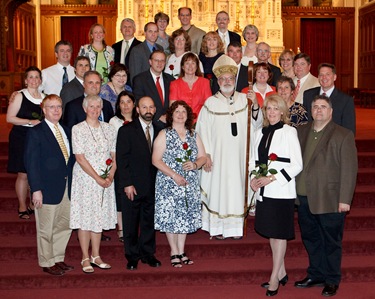
. . . and with the Golden Anniversary couples:
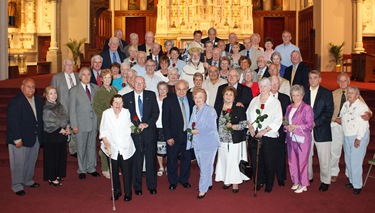
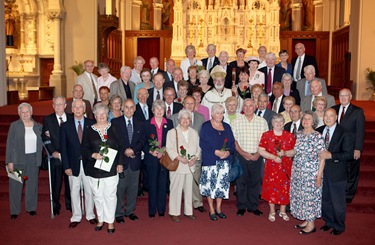
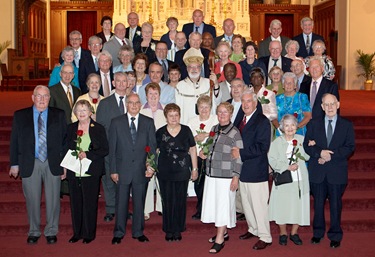
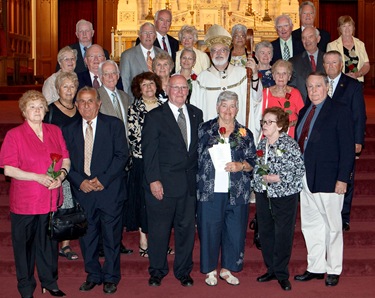
– – –
That evening, I went to the home of Michael Shaughnessy in Hingham for a Catholic Foundation event. There was a very large group of people there.
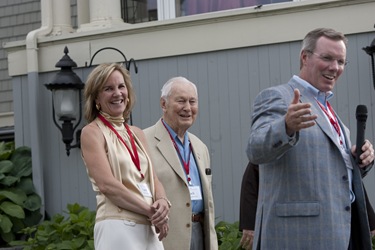
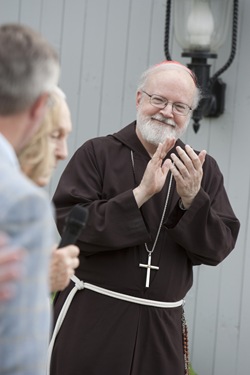
The Shaughnessys have a lovely home right on the water and we were out on their patio as Father Bryan Hehir spoke about the mission of Catholic Charities and I talked a bit about the works of the archdiocese.
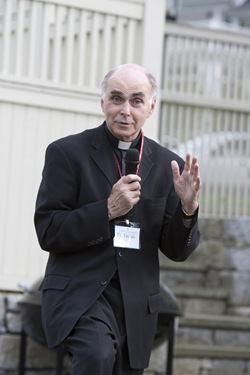
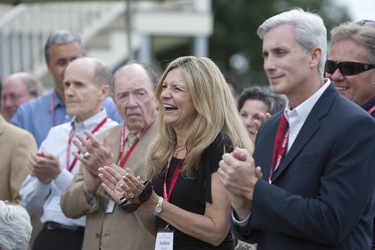
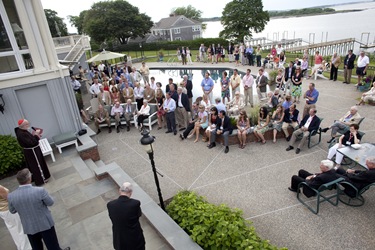
– – –
On Monday, I went to the Catholic University of America in Washington, D.C. I am on their Board of Trustees and this year, at the invitation of Justice Samuel Alito, the board was invited to have a dinner at the Supreme Court building.
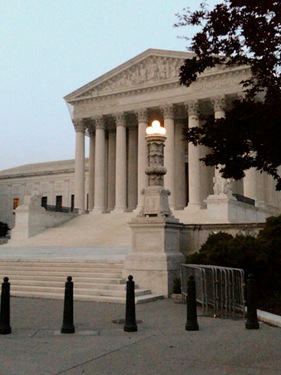
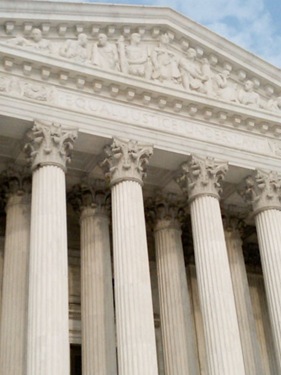
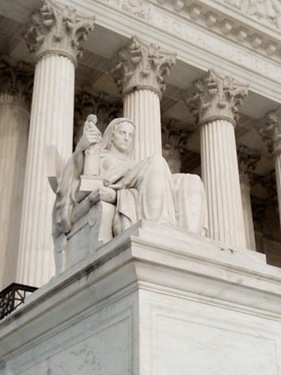
As many times as I have been outside the Supreme Court (every year at the March for Life), it was the first time I had ever been inside. It is a very historic and beautiful building in Washington.
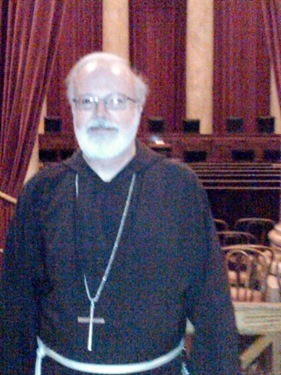
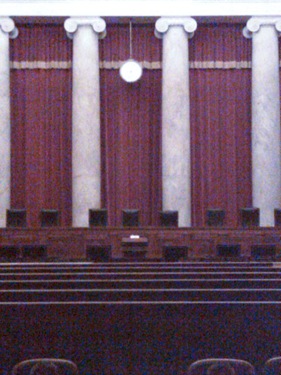
At the dinner they presented the President’s Medal to Bishop William Lori, who was finishing his term as the chairman of the board. Bishop Lori will be succeeded by Bishop Allen Vigneron, who is the Archbishop of Detroit and an alumnus of CUA.
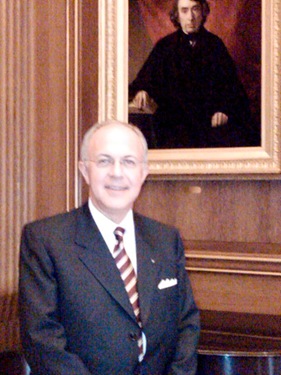
Supreme Knight Carl Anderson is standing in front of a portrait Chief Justice Roger B. Taney, who was the first Catholic on the Supreme Court
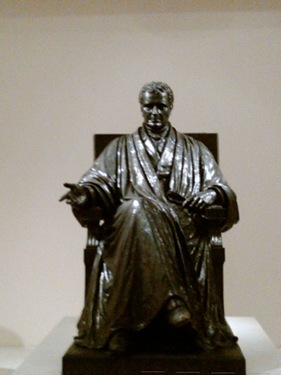
A statue of John Marshall, who was the first Chief Justice of the U.S. Supreme court
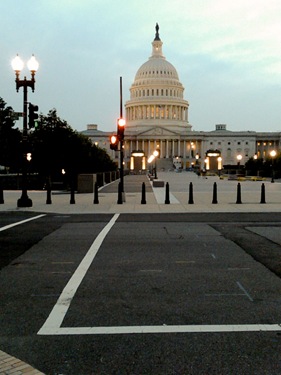
– – –
Then on Tuesday was the conclusion of the National Symposium on the Present and Future of Catholic Hispanic Ministry in the United States at the new Boston College facilities in Dover.
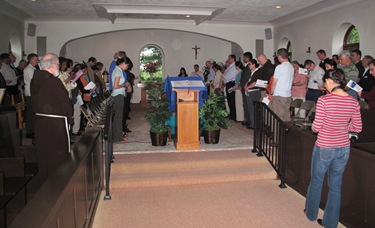
The Symposium, which gathered around sixty Church leaders, scholars and practitioners from around the country, was organized by Boston College in partnership with Loyola University and Barry University.
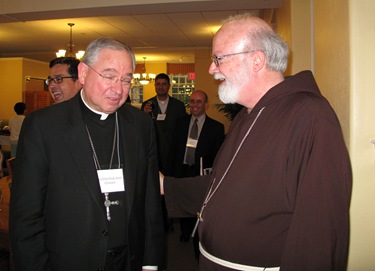
Archbishop Gomez
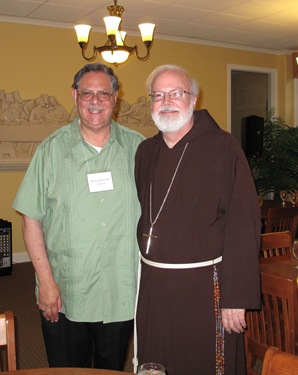
Bishop Garcia
The chairperson was BC professor Hoffsman Ospino. Archbishop José Gomez from the Archdiocese of San Antonio, Bishop Jaime Soto of Sacramento and Bishop Richard Garcia of Monterrey, California attended the event. Jesuit Father Allan Deck, director of the Secretariat of Cultural Diversity in the Church at the USCCB, was also a participant.
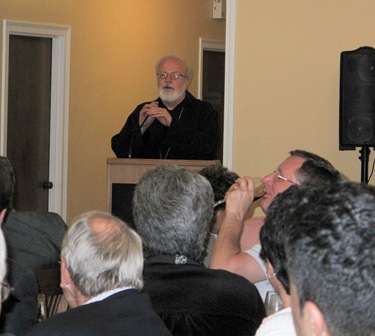
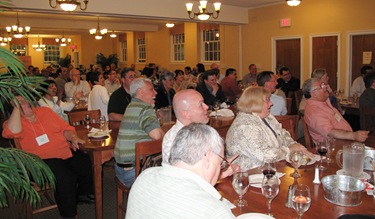
We had a vespers ceremony followed by a dinner during which I addressed the people and shared with them some of my experiences working in Hispanic ministry. I spoke about the importance of what they are doing and thanked them for their commitment to working for the Hispanics in our Church.
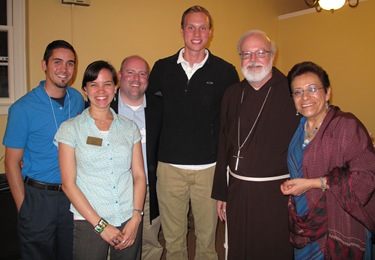
– – –
On Wednesday morning I celebrated Mass and had breakfast with the Heralds of the Gospel, an International Association of Pontifical Right. They were first established by Pope John Paul II in 2001, and they already have thousands of consecrated men and women and are present in 57 countries world-wide.
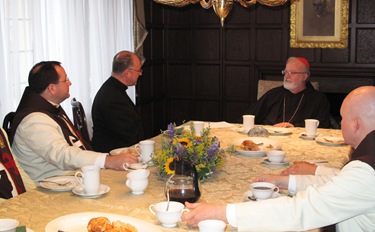
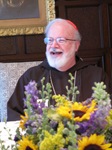
They came to Boston for a visit, and to bring with them the pilgrim image of the Immaculate Heart of Mary to various parishes and schools of the archdiocese. I was so impressed with their love and devotion for the Eucharist, the Blessed Mother and the Holy Father. They sang beautifully during the Mass, and most of their repertoire was the old Latin chants I learned as a young friar.
It was wonderful to be with them and to hear about all the exciting things they are doing to evangelize in different countries. I also have to say that they looked pretty impressive in their very distinctive habits!
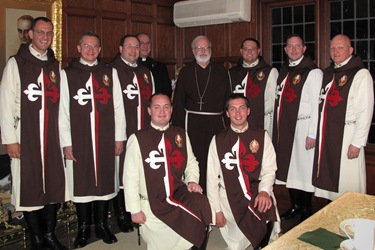
– – –
Then, in the afternoon, we held our Presbyteral Convocation for the Inauguration of the Year for Priests.
We were very pleased at the great turnout and enthusiasm of our archdiocesan priests –nearly 400 attended the gathering which was held at the Burlington Marriott.
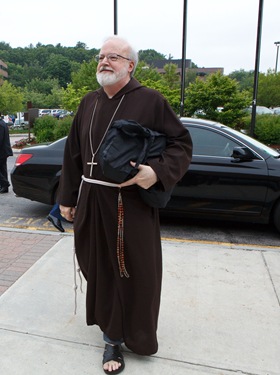
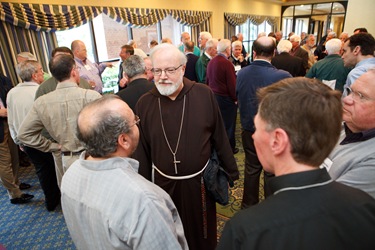
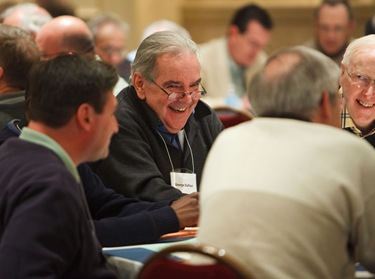
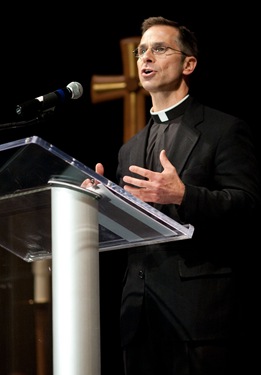
Father Bryan Parrish offers his reflection
Father Bryan Parrish, the Pastor of Holy Family Parish in Duxbury, gave an extraordinary testimony and was very eloquent in sharing his own experience and love for the priesthood.

Father Knott
The keynote speaker was Father Ron Knott, a priest of the Archdiocese of Louisville, who has written and lectured extensively on intentional presbyterates. His thesis is that the presbyterates need to function with great unity among the priests and the bishop instead of being private practitioners, as he calls them, or divided into tribes.
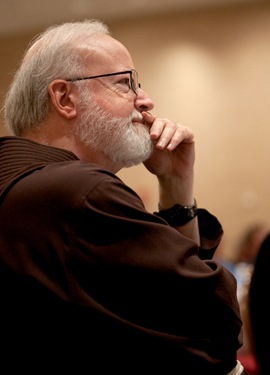
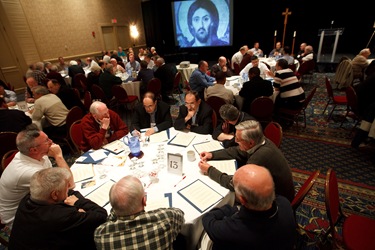
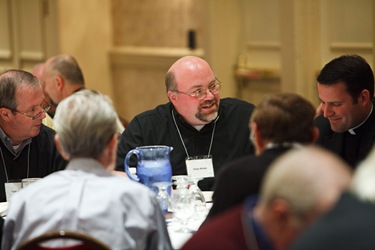
He said that sometimes, nation-wide, there are great fissures in the presbyterates between groups of priests with different ideologies or of different ethnic groups. He challenged the priests to forge a real unity among themselves and with their bishop in order to be effective in their ministries. He gave an excellent talk. The priests and bishops were very pleased.
I also addressed the priests and I’d like to share the text of my talk with you here:
Years ago if you would have told me that someday I would be riding around in a shiny black car with tinted windows and a vanity plate, I would have asked what you were smoking.
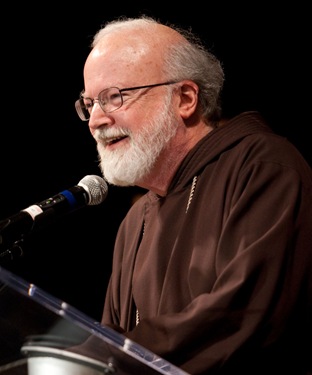
When I was a priest in D.C. at the Centro Católico, the vehicle I drove was affectionately called “Scarface” by the kids in the neighborhood. The C&P telephone company when they retired their telephone repair trucks from service would donor them to local non-profits. I was the beneficiary of their largess.
Now Scarface was in deplorable condition but I had a number of gypsies in my parish. Anybody who didn’t fit into a more conventional parish eventually ended up at the Capilla Latina. The Roma people usually spoke a few languages and Spanish was one.
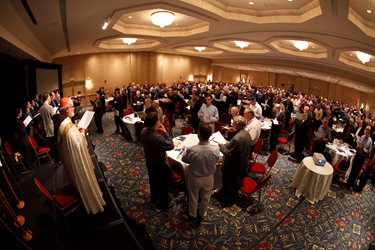
Some of the Gypsy women made a living by palm reading, the men usually did body work on cars. Quite obligingly, they banged out all the dents and painted the rusty spots and over the telephone company logo with patches of brown primer, leaving what one might describe as a piebald or leopard spot effect. Scarface had wooden benches in the back cabin, so we could transport many people in the trunk. There was a ladder on the roof. Once a cop stopped me and asked what the ladder was for. I told him it was for second story jobs.
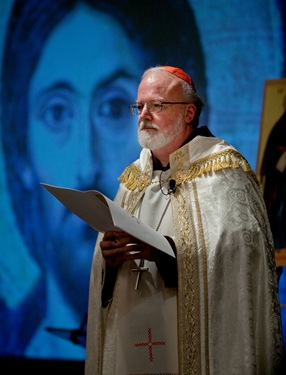
However, Scarface was a luxury liner compared to the car I acquired to start a painting company. When I was working with prisoners I was very distressed that no one could get a parole without first securing a job, so I decided that I would hire the prisoners. Accordingly I started a painting company. I knew nothing about painting companies – no, I knew less than nothing. My Dad gave me a thousand dollars seed money. I bought ladders and brushes and paint, and with the money that was left over I bought a car, an old red station wagon that only went in reverse. I went to the Capuchin superior and asked for money, he said: “Brother, make do.” We went to the first job driving backwards. With the money we earned, we fixed the car; and eventually the painting company flourished, even though we looked like Hell’s Angels with paint brushes.
When I was named Archbishop of Boston, the headline in the NCR was: “O’Malley gets fixer upper.” It was clear to me that all the gypsies, Hell’s Angels, the king’s horses and the king’s men would hardly be able to do it.
But I never doubted that the Church is the Lord’s. It is not about me. This is the Body of Christ, the Bride of Christ, the people of God. Still I never suspected 6 years ago where we are today, not problem-free, but in a much better place… and The Globe is on the skids.
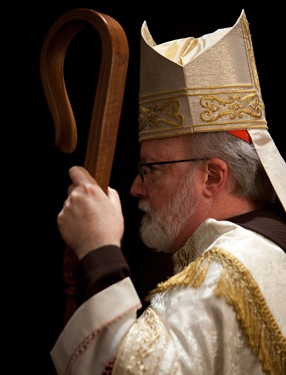
What has given us the resilience to bounce back is the faith of so many wonderful Catholics and an extraordinary group of priests. Boston has produced so many holy, committed, talented priests, serving the Church in the parishes, hospitals, schools, in the missions, in the military. You will have to go a long way to find a Father Bryan Hehir and a Father Rich Erikson.
One of our pastors, Father Mike Hobson, is going to the Carthusians this summer to test a vocation to that way of life. I hope you read the article in last Sunday’s Globe about Father Jim Field and the extraordinary way he is ministering to his parish and at the same time facing his own mortality with faith and courage. The same can be said of Msgr. Tom McDonald and so many great priests of Boston. The generosity of those serving in the missions 30-50 years is truly inspiring. We now have two more Boston priests who have volunteered to enter the St. James Society. And our priests have done many tours of duty in Iraq and Afghanistan, serving our military personnel in their hour of greatest risk.
And in our difficult parishes here men are serving with a love and generosity that is inspiring. Some, like John Connolly, are still pastoring well into their eighties. Bishop Boles and so many retired priests help in sundry ways and work as hard as anyone. Msgr. Andy Connell made Boston’s one of the most successful Propagation Offices in the world. Msgr. John McDonough and Father Ed Condon have given so generously of their time to serve the priests and people of Boston. We have so many exemplary priests who are pastoring in so many creative ways like Father Frank Kelly and Father Walter Waldron. And men pastor effectively in parishes with schools, huge sacramental indexes in the suburbs, some with multiple worship sites.
Gathering the presbyterate together today give us the opportunity to thank God for the gifts of our priests and to thank you on my own behalf and that of the Catholic community that depends on your ministry and holds you in the highest esteem and in genuine affection.
We are poised to begin a Year for Priests that our Holy Father Pope Benedict has given to us to mark the 150th Anniversary of St. John Marie Vianney the Curé of Ars. We were privileged to have had the saints’ relics here in Boston and to have experienced the outpouring of love and devotion to this saint who models for us priestly ministry after Jesus’ own heart.
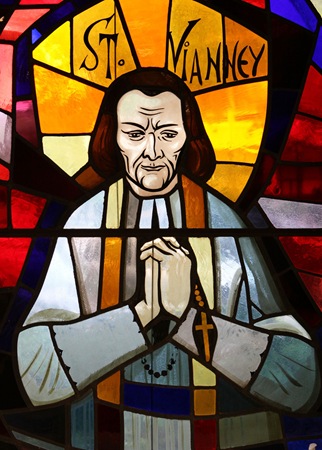
The first salient point of the Curé’s life is his tenacity in pursuing a priestly vocation. There were so many obstacles, yet he never swerved from the path. That same sense of courage and determination proved invaluable when he was confronted by a difficult pastoral assignment. (Let me make an aside here to acknowledge once again so many of our priests who over the years have taken very difficult assignments and fulfilled them with a spirit of generosity and sacrifice.) In the Curé’s life, we see the challenge of trying to work in a situation that, humanly speaking, seems impossible. John Vianney confronted indifference, hostility, cynicism in a post-French Revolution world where the culture had been turned upside down. In many ways the state of crisis in the Church in his day parallels the challenging situation the Church faces in today’s world.
There were so very good mentors in John Vianney’s life, holy priests who reached out to help this rather lackluster cleric of limited abilities. The encouragement and good example of these holy priests set him on a path that led to his own transformation and that of his parish.
Father Kevin O’Leary often talks about his first pastor who helped him learn his priestly identity, teaching him how to be available to his people and who taught him to celebrate every funeral as if it were for his own Dad. That is the kind of mentoring we need for our new priests.
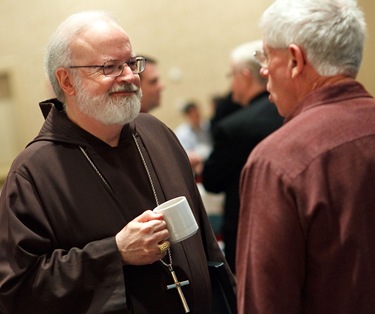
The Curé of Ars was a man who certainly practiced what he preached. I am always struck by the lesson from Matins for his feast day where the Curé of Ars is urging us “to love and to pray.” These were certainly the two things that characterized and energized his ministry. He loved the people he was sent to serve, even when they didn’t like him, or were totally indifferent, or when they openly opposed him. He knew instinctively that his principal task was to rescue the Lost Sheep who far outnumbered the saved ones.
As I mentioned at the Chrism Mass, the Good Shepherd leaves the 99 to pursue the one lost sheep; so often we jealously guard the one saved sheep and let the 99 drift away. The Curé of Ars never took his eye off the lost sheep. He never tired of reaching out, encouraging them and welcoming them home. It is like that sign “I thirst” that Mother Teresa has placed next to the tabernacle in all the Sisters’ homes. The Good Shepherd even in the moment of pain and suffering is focused on the need to save sinners, to heal them and bring them home, even when they need to be carried on His shoulders.
The Curé of Ars was not driven by a desire for popularity. I always like the story of the old biddies in the parish who had the Curé of Ars celebrate a Mass each Wednesday for a special intention. After several months it was evident the intention of the ladies had not been answered. The Curé was curious and asked what the intention was. The ladies explained: We are praying that the Bishop send us a new priest.
Part of the identity of a diocesan priest must be love for his people. Not a love that is self-seeking or narcissistic, but a love that translates into an overwhelming desire to help people know God and experience His love. A desire to help people lead a good life that will prepare them for eternal life by living a life of faith. Our faith is not baggage that burdens, but is a wing that lifts people up and leads to true happiness.
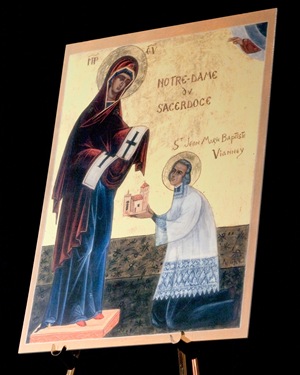
Our celibacy must be able to express our pastoral love. The Curé of Ars once said: “A soul adorned with the virtue of chastity cannot help loving others, for he has discovered the source and font of love — God.”
For a diocesan priest, celibacy means a special fatherhood, a life-giving love for our people. As fathers make so many sacrifices to feed, clothe and educate their children so the priest, a spiritual father, makes countless sacrifices for the people God has entrusted to him to ensure their salvation.
Pope John Paul II in his very moving Holy Thursday letter on the Curé of Ars said that the Curé’s ministry consisted primarily in purifying people’s consciences and teaching them the faith — both activities which are oriented toward the Eucharist.
Renewal in the Church only comes through conversion. As priests, we must struggle daily with our own conversion. We have been entrusted with the power to heal, to forgive sins, to give people a second chance, to be liberated. That is also part of our priestly identity. We, like the Good Shepherd, are to be icons of the Father’s Mercy: We can do what no psychiatrist, no doctor, no psychic nor scientist can do. We can say: “Go in peace, your sins are forgiven.”
During this Year for Priests, we have planned, after consultation with the Presbyteral Council, a “Leaving the Lights On” Program by which we will have confessions available on Wednesday evenings during Advent and Lent. We hope to prepare for this by a catechesis and advertising campaign that will encourage our Catholic people to reconnect with this sacrament of the Lord’s mercy. As priests, this sacrament must be a part of our own spiritual journey. As my Dad used to say, “When it’s time to get a haircut, it’s time to go to confession.”
I hope that we will embrace this project with the same love that the Curé of Ars and Padre Pio exhibited for the confessional as the throne of God’s mercy and an expression of our own pastoral love for God’s people and our desire to see them live graced lives in God’s friendship.
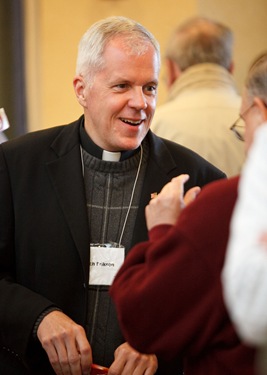
The Curé of Ars was a teacher of the faith. In an age of religious illiteracy and a generalized addiction to entertainment, it is not easy to teach the faith. The pulpit, the parish bulletin, the parish website, the CCD classes, the parish school, the adult education classes, the RCIA Programs, to mention a few, are all opportunities to mentor new disciples in the faith.
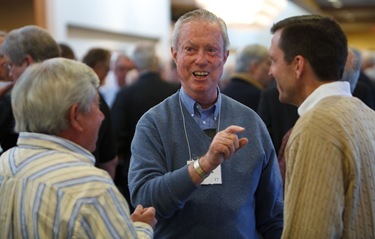
Our own life of study, ongoing formation and personal reflection help equip us for this challenge. We must help people see how the various aspects of our faith are interconnected and how they flow from Christ, who is the Head of the Church. We must first help people to know Christ, to experience His love, and then the hard words of the Gospel become the yoke that is sweet and the burden that is light. The role of piety and devotion in the life of the Church cannot be overlooked as we try to help people have a personal relationship with the Lord. A religion that is too cerebral fails to touch people’s hearts.
It is my ardent hope that this Year for Priests might be an occasion when we all commit more time to prayer. According to the St. Luke study, only 48% of our priests pray more than 30 minutes a day. If we are going to persevere in prayer we all need a game plan, a rule of life that ensures that we make time and space for God in our lives. The breviary, daily Mass, some meditation should be the centerpiece of a priest’s spiritual life. Marian devotion and Eucharistic piety are also essential for the priest. Our yearly retreat and yearly check up with the doctor is the way we responsibly take care of ourselves. And to neglect either is an egregious mistake. I can think of nothing that could excuse one from these minimal kinds of self-help.
Likewise spiritual direction, spiritual reading, and days of reflection can all support us in our interior fitness.
As Father Ron Knott has so cogently presented, we must return to the ancient theology of a presbyterate — an intimate sacramental brotherhood, which has been replaced by a strong notion of individual ministry.
Priests cannot be private practitioners or form tribes within their presbyterates — no lone rangers and no Maytag repairmen. We must develop a corporate sense of priestly identity and mission. We must become men of communion. We are a large presbyterate but that does not mitigate the need to seek paths of unity.
In families we often hear of the need for quality time together. I would like to propose two vehicles for this quality time. For us, these are not the only two ways, but these already exist and can easily be enhanced. I am referring to the vicariate meetings and priest support groups. I believe that the two complement each other and can contribute to our growth as a presbyterate. About one-third of our priests belong to some sort of support group, to Emmaus groups, etc. I meet regularly with those ordained in the last five years. (That is usually the demographic which usually exhibits the highest attrition, but in Boston we have not lost any priests ordained since the year 2000.) Typically we gather for a holy hour, dinner and a couple of hours of shared reflection on priestly life, ministry, challenges and opportunities. In general, I think that the experience is life giving for all of us. It is my hope that this experience will give our young priests a desire to participate in priestly support groups and to be sensitive to the needs of brother priests.
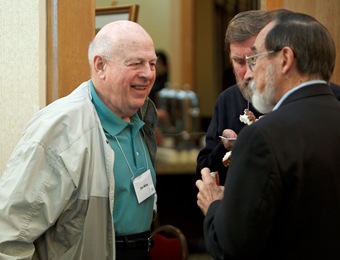
I have asked Bishop Hennessey and Father Bill Kelly to help develop a plan that would help to establish more groups for priestly support during this Year for Priests. It is my belief that if we have strong groups of fraternal support where we can witness to each other, encourage one another, and understand each other, then we will be able to build a communio among ourselves that we can model for our people.
A spirit of cynicism and negativity, a rejoicing over evil, a sense of competition and one-upmanship is poisonous to priestly fraternity and to the Body of Christ. We must learn to banish clerical jealousy, to celebrate each other’s successes and mourn each other’s failures, rather than rejoicing when a rival has problems or lamenting the good fortune of a brother priest. In one of Power’s novels, he talks of a priest in a rural village in Ireland who installed indoor plumbing. His classmate in the next village was not to be outdone and installed a toilet in his rectory on the second floor even though there was not enough water pressure to ever use it. However, visiting clergy were always given a tour of the second floor bathroom, which of course eclipsed any first floor water closet.
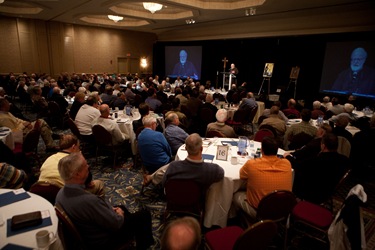
We are called to be brothers, but not necessarily twins. I am reminded of the famous scene from Father Flanagan’s “Boys Town” where the boy is carrying a lad on his shoulders and says, “He ain’t heavy Father, he’s my Brother.” The more we become friends, and the more we become focused on Christ and on the mission of announcing the good news of building a civilization of love, the more Christ’s Church will flourish. Internal divisions, polarization, and highly personalized theologies shatter the unity of the presbyterate and of the Church.
Support groups tend to bring together like-minded men, or men who share certain experiences, similar ages. This can give a natural cohesiveness to the group and help guarantee the survival and health of a support group.
The Vicariate meetings based on geography are usually less homogenized and might represent a wider spectrum of age, opinion and experience. The focus is often less on personal growth and more about pastoral life. Still it can be a unique opportunity to build priestly fraternity and to allow a conversation to take place in which every voice can be heard. Everyone needs to have a stake in making a good vicariate meeting. With time for shared prayer, discussion, planning, analyzing and dreaming together about how we can better carry out our mission as Christ’s Church. To a great extent the success of the Presbyteral Council depends on the vibrancy and participation of the priests in their Vicariate meetings.
The success of the Vicariate meetings and the strength of priestly support groups will depend on our willingness to commit ourselves to minister to one another in order to build a unified and strong presbyterate. Pastors make such great sacrifices for their people of the parish. We must see that an essential part of our ministry is to minister to the priests and to make the whole diocese “your parish,” especially those sectors where there are the greatest needs.
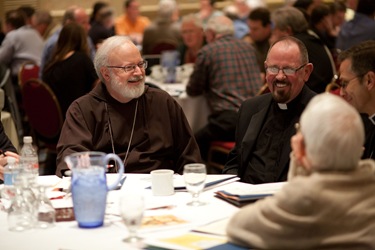
Fruitful discussion and recommendations that can be clearly communicated to the Priests’ Council can enrich the work of the council and allow members of the Presbyteral Council in some way to be representatives of the priests in the Vicariates. The Vicariates can help us to know best practices, to identify problems that need to be addressed, and help find more effective ways of collaboration in carrying out the Church’s Mission.
The only way that we will be able to love God’s people like the Curé of Ars, the only way we will truly be spiritual fathers is if we are men of prayer. “To love and to pray,” as the Curé of Ars says. The two are inseparable. It is impossible to overcome our selfish motives, insecurities, and laziness without being connected to the source of our spiritual energy by a profound life of prayer. I do not expect that we will rush to replicate the prayer life of the Curé of Ars, but I hope that this Year for Priests will afford us an opportunity to recommit ourselves to the interior life, to that intimate friendship with Christ which, more than any other attribute, enables us to be icons of the Good Shepherd for our people.
Two events that I participated in during the last couple of weeks are emblematic of what the Church in Boston is becoming. First of all, our ordination of six new priests, including a widower, an Irish immigrant, a Vietnamese refugee and an Hispanic. And last week I had Confirmation in the Cathedral on Pentecost Sunday in Portuguese for the Brazilian community. There were 240 young people confirmed in a three-hour ceremony. There were about 2000 people in the Church. The amazing thing is that in all those people, I could not count five with white hair, and it wasn’t because they were using Clairol. There were very few persons under the age of fifty in the Church.
This parallels my experience working with immigrants in D.C. I would typically have one funeral for every 70 baptisms. The presence of so many immigrant groups from Asia, Latin America and Africa is a great challenge but also a wonderful opportunity for our faith community. The Catholic Church in the U.S. grew by 1 million last year — while the Episcopal Church is losing about 20,000 people a year — which for them translates into one diocese a year.
I am of course grateful for all of the parishes that reach out to these new communities. It is not easy to forge multi-ethnic parishes like Sacred Heart in Washington, D.C., where my community works. Each weekend there are three Masses in Spanish, one in Vietnamese, one in Haitian Creole, and one in English. Once, after a long and difficult Parish Council meeting, an elderly American parishioner of many years suggested to the Pastor: “Father, if we just stopped serving coffee after Mass, maybe these people would go away.” Running a multi-ethnic parish is a great challenge, but it is also an opportunity. The Arise Program and the Cursillos have been successful in involving many persons from various language groups and at the same time create a space where the various groups can intersect and experience the catholicity of our Church.
It is good to reflect on the fact that the majority of Catholics in the U.S. between ages 20 and 30 are Hispanic. We are an immigrant Church, we must never lose sight of that.
As I prepare to mark 25 years as Bishop, I recall how one of the friars asked me, “How did you ever become a Bishop? You were never Provincial, you were never Guardian, you never studied in Rome, you are not a canon lawyer, you don’t even own a pair of shoes let alone a pair of cufflinks, and you drive around in that ridiculous telephone repair truck. You never worked in the chancery. You were never a monsignor. How come?”
I honestly do not know. I was thunderstruck. Indeed, the day I found out I was named bishop, there was an eclipse of the sun. I almost went to the gypsies to get a read on that one. But let me explain one hypothesis that was very strong in Washington at the time for those of you who like conspiracy theories.

Much of my time in Washington was working with undocumented aliens and women who worked as servants, domestics and cleaning women. I served on a commission of Mayor Marion Barry along with the feminist icon, Gloria Steinem, to set the new minimum wage for domestic workers. My work brought me into conflict with the international community in Washington. Every week I dealt with cases of domestic workers who were working for diplomats who exploited them shamelessly. One woman had worked 70 hours a week and had not received a penny in wages for 4 years. Typically, these diplomats took their passports away from them and kept them in bondage. When I would confront the employers they would always say: “Somos muy católicos y la tratamos como un miembro de nuestra familia” (“We are very religious. We treat her like a member of our family”)! My rejoinder was always: I am glad that I am not a member of your family.
In 1984 the Holy See was offered full diplomatic relations by Washington thus giving the Vatican representative diplomatic status in the United States, with the privilege of license plates, tax benefits, parking at the airport, etc.
Shortly thereafter it was announced that I had been named Bishop in the West Indies. It was reported to me that there was a huge party in the Organization of American States (O.A.S.) because I was being sent away. In fact, they were saying that my being named Bishop in the West Indies was the result of a secret deal between the Vatican, the O.A.S. and the State Department: “You get rid of O’Malley and we will make your man in Washington a diplomat.” Postea ergo propterea.
Is it true? Could be. Maybe Dan Brown will do a novel about it one day.
Regardless of what forces were at work, I thank God for the loving providence that has been so evident in my life despite my unworthiness and ineptitude. And I thank him for making me your brother and your Bishop.
Let us use the Year for Priests well, so that as I said at the Chrism Mass, we might take time to repair our nets together — and prepare for the miraculous draught of fishes.
Until next week,
– Cardinal Seán
